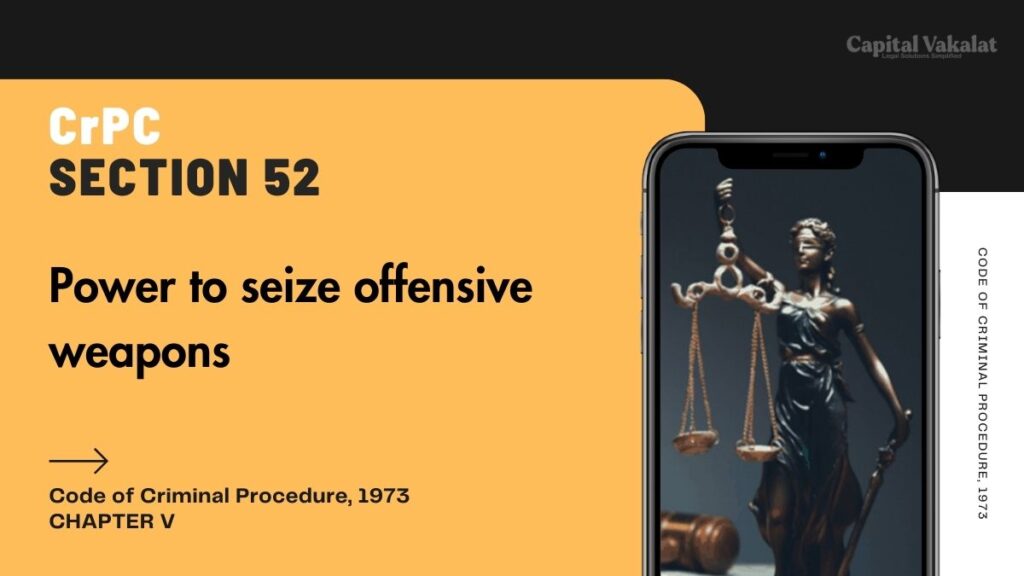The power to seize offensive weapons under Section 52 of the Criminal Procedure Code (CrPC) plays a crucial role in maintaining law and order. This provision empowers law enforcement agencies to confiscate weapons that pose a threat to public safety. Understanding the scope, application, and implications of Section 52 CrPC is essential for both law enforcement and the public.

This article delves into the intricacies of this legal provision, exploring its significance and real-world impact.
Bare Act. Section 52 Cr.P.C.
Power to seize offensive weapons.
The officer or other person making any arrest under this Code may take from the person arrested any offensive weapons which he has about his person, and shall deliver all weapons so taken to the Court or officer before which or whom the officer or person making the arrest is required by this Code to produce the person arrested.
Understanding Section 52 CrPC
Section 52 of the Criminal Procedure Code grants the police the authority to seize any offensive weapon found during the arrest of a person. This power is integral to ensuring that individuals who are arrested do not pose an immediate threat to others. The term “offensive weapon” is broadly defined, encompassing any object that can cause harm or injury.
Historical Context and Evolution
The origins of Section 52 can be traced back to colonial India, where the British authorities recognized the need for stringent measures to control violence. Over the years, this section has evolved, adapting to the changing dynamics of crime and public safety. The evolution reflects a balance between empowering law enforcement and safeguarding individual rights.
Legal Interpretation and Judicial Precedents
Judicial interpretation of Section 52 CrPC has played a significant role in its application. Courts have examined various cases to delineate the boundaries of this power. Landmark judgments have clarified what constitutes an offensive weapon and the conditions under which seizure is justified. These precedents provide a framework for law enforcement to operate within legal bounds.
Procedure for Seizure of Offensive Weapons
The process of seizing offensive weapons involves several steps to ensure legality and fairness. When an individual is arrested, the police must immediately search for and confiscate any weapons. The seized items are then documented and submitted to the court. The accused has the right to challenge the seizure, and the court evaluates the legitimacy of the police action.
Role of Law Enforcement Agencies
Law enforcement agencies are the primary executors of Section 52 CrPC. Their training includes identifying offensive weapons and conducting lawful seizures. This power is crucial in preventing crimes and ensuring the safety of both the public and the police. Regular audits and oversight mechanisms are in place to prevent misuse of this authority.
Impact on Public Safety
The ability to seize offensive weapons significantly enhances public safety. By removing potentially dangerous items from individuals during arrests, the risk of violence is minimized. This provision acts as a deterrent, discouraging the carrying of weapons and thereby reducing crime rates. It also reassures the public that measures are in place to protect them.
Challenges and Criticisms
Despite its importance, Section 52 CrPC is not without challenges. Critics argue that the broad definition of offensive weapons can lead to misuse and arbitrary seizures. There are concerns about the potential violation of individual rights and the lack of clear guidelines. Addressing these issues requires ongoing dialogue and reform to ensure the law is applied justly.
Case Studies and Real-Life Examples
Examining real-life cases where Section 52 CrPC has been applied provides valuable insights into its effectiveness. Instances where timely seizure of weapons prevented crimes highlight the law’s utility. Conversely, cases of alleged misuse underscore the need for stringent oversight and clear procedural guidelines.
Comparative Analysis with International Laws
A comparative analysis with similar laws in other countries offers a broader perspective. Many nations have provisions for the seizure of offensive weapons, but the specifics vary. Studying these differences can inform potential improvements to Section 52 CrPC, ensuring it aligns with global best practices while addressing local needs.
Future Prospects and Reforms
The future of Section 52 CrPC lies in balancing enforcement with rights protection. Potential reforms could include clearer definitions of offensive weapons, enhanced training for law enforcement, and stronger oversight mechanisms. By addressing current challenges, the law can continue to serve its purpose effectively in a changing societal context.
Conclusion
Section 52 CrPC: Power to seize offensive weapons is a vital legal provision that significantly contributes to public safety. Its effective implementation hinges on a balanced approach that empowers law enforcement while protecting individual rights. Through continuous evaluation and reform, this law can adapt to contemporary challenges, ensuring it remains a robust tool in the criminal justice system.
Frequently Asked Questions
Can the seizure of weapons be challenged in court?
Yes, individuals have the right to challenge the seizure of weapons. The court evaluates the legality of the police action and decides whether the seizure was justified.
How does Section 52 CrPC ensure public safety?
By allowing the police to seize weapons during arrests, the provision reduces the risk of violence and crime. It acts as a deterrent, discouraging individuals from carrying offensive weapons.
What are the potential criticisms of Section 52 CrPC?
Critics argue that the broad definition of offensive weapons can lead to arbitrary seizures and potential misuse. There are also concerns about the violation of individual rights.
How does Section 52 CrPC compare to similar laws in other countries?
Many countries have laws for the seizure of offensive weapons, but the specifics vary. Comparative analysis helps identify best practices and potential areas for reform in Section 52 CrPC.
What reforms could improve the application of Section 52 CrPC?
Potential reforms include clearer definitions of offensive weapons, better training for law enforcement, and stronger oversight mechanisms to prevent misuse and ensure fair application.